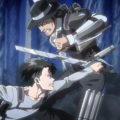Geek Babble – Looking 20 years back to 9/11

In 2008 Geoff and I started Damage Control as largely a video games and pop culture blog. Every so often, we veer into politics. These days much of that has been centered on the pandemic, especially with Quarantine Control. Today is no different in regards to politics and history. We had a staff discussion on if we should carry on this Saturday as normal and stream video games on Twitch, or do something to mark the 20th anniversary of September 11. In the end, Drew decided not to stream and Joseph and I decided to write about the anniversary.
When bringing up 9/11 to people old enough to remember the day, it is customary to share what you were doing when you first heard the terrible news. My morning was uneventful. I slept through most of the events as they unfolded. 20 years later my morning routine still consists of sleeping. Same job (I even got a 20-year plaque in August), nearly the same hours. On that particular morning I hauled myself out of bed at around 10. I grabbed my GameBoy Color, turned on Pokémon Gold and then the TV. CNN didn’t have my full attention, so when the Twin Towers were mentioned I said “again?” thinking of the February 1993 bombing. It wasn’t until about 10:28 when I heard screams that my full attention snapped to the TV as the North Tower came crashing down.
The rest of my morning and afternoon were spent responding to emails from high school and online friends. In June I had moved back to Philadelphia from Phoenix and my friends in Arizona had heard about United Flight 93’s crash in Shanksville. Not knowing how far away Shanksville was from Philadelphia (226 miles west), they wanted to make sure I was okay.
I spent my evening at work, indignant over the fact that we actually had to come in on one of the darkest days in American history. I learned 19 years early what it meant to be an essential worker. As soon as I got home, I went right back to watching an unhealthy amount of CNN coverage. Like everyone else, I was scared, horrified, and angry. The country was united like never before. For better and worse, the world changed in ways that would have long-lasting consequences that still aren’t completely clear.
I actually wrote a bit about 9/11 in December 2020 for two Quarantine Control columns. Today’s the big anniversary so I have a lot to cover.

On one bright morning on the second Tuesday in September 2001, a timeline 11 years in the making unfolded. The actions of 19 men supported by an entire network abroad and within would send the country down a dark path.
At 8am American Flight 11 departed from Logan International Airport in Boston. It was headed for Los Angeles International Airport, but 14 minutes into the flight five hijackers led by Mohamed Atta took control of the plane. Around 8:20 Atta accidentally broadcasts a message for passengers to remain calm to air traffic controllers in Boston. Around the same time, flight attendants Betty Ong and Amy Sweeney call American Airlines to notify them of the hijacking and to pass on vital information. While this is happening American Airlines scrambled to let the military know what was going on. At 8:46 the Boeing 767 crashes into the North Tower of the World Trade Center between floors 93-99. 1,355 people would find themselves trapped above impact zone, unable to escape because all three of the tower’s emergency staircases were destroyed. An additional 107 people below the impact zone would also die. The North Tower collapsed at 10:28 that morning, 102 minutes after impact.

At 8:14am United Airlines Flight 175 departed Logan International Airport also headed to Los Angeles. At 8:46 the hijackers led by Marwan al Shehhi take over the plane. Passenger Bryan Sweeney calls his wife Jules to notify her that his plane was hijacked and to say goodbye. He knew the outlook was grim. (Bucks County, PA local Victor Saracini was the pilot of Flight 175.) Shehhi tips the massive Boeing 767’s wings diagonally as he strikes the South Tower at 9:03 between floors 77 and 85. Dozens of people waiting for elevators in the 78 floor’s Sky Lobby are killed or injured when a wing slices through the floor. At 9:59am or 56 minutes after impact the South Tower would collapse, killing 630 people. Many lives were saved because thousands of occupants decided to leave after the North Tower was struck. Unfortunately, many stayed or returned to their desks after being notified their tower was safe and secure, not knowing they would be in a similar predicament in less than 20 minutes. In this tower the plane did not destroy all of the stairwells, allowing 18 people from above the impact zone to escape.

At 8:20am American Airlines Flight 77 leaves Washington Dulles International Airport. The Boeing 757 was headed to Los Angeles. A half hour later around 8:50 the flight is hijacked. This group of five is led by Hani Hanjour. Around this time the FAA scrambled to suspend flights and civilian planes were told to land immediately as military fighter jets (NORAD) took to the air. These efforts were thanks to phone calls received earlier from the crews on AA Flight 11 and UA Flight 175, and the FAA. These efforts would be too late to stop Flight 77, or to find any of the hijacked plans as transponders had been turned off. Around 9:24 passengers and crew make final calls to their family. At 9:37 Hanjour smashes the plane into the western side of the Pentagon. This side of the building was under construction and was not heavily occupied. Still, 125 people would lose their lives as three of the outer rings of the Pentagon were instantly destroyed. Thanks to the incredibly sturdy design of the building, personnel were able to evacuate before the struck section of the building collapsed.

At 8:42am United Airlines Flight 93 takes off from Newark International Airport. This Boeing 757 was bound for San Francisco International Airport and left late thanks to delays. Just as the pilots are receiving warnings via text message about hijacked flights at 9:28 the four hijackers led by Ziad Jarrah began their cockpit takeover. First Officer LeRoy Homer is heard screaming “Mayday! Mayday!” just before the voice of Jarrah broadcasts a message to the passengers to stay calm, and bluffs he has a bomb onboard. This message is also broadcast to Cleveland Air Traffic Control along with other sounds from the hijacking. Unlike the other three flights, the passengers are well aware of what’s happened in New York City and Washington, D.C. They know if they don’t intervene countless other people will die.
Notably, flight attendants CeeCee Lyles and Sandra Bradshaw call their husbands. Lyles’ husband doesn’t answer and her message is picked up by answering machine. Other passengers call their loved ones as others vote to rush the cockpit and take back the plane. Many passengers hanging back stay on their phones during the fight. One of the hijackers outside the cockpit was dispatched by the revolt. In response Jarrah rolled the plane side to side to knock the passengers off their feet, but they broke into the cockpit anyway and struggled to take control of the yoke. Just before the passengers could take the plane back, the hijacker rolls it upside down and plows it into the fields of Somerset County, PA at 10:03. It was believed Jarrah was headed to either the Whitehouse or the U.S. Capitol building. Thanks to the heroic efforts of the passengers on Flight 93 the hijackers’ final destination will remain unknown.
Noteworthy people who died and survived that day include:
- Special FBI Agent John O’Neill – He devoted his career to stopping and hunting down members of Al Qaeda. He always felt the terrorists would be back to finish off the World Trade Center. Just as he heard disturbing news about an upcoming attack, he was forced to retire from the FBI and took a security job at the WTC. He died on 9/11, found in a stairwell of the South Tower.
- Betty Ong – She was the first to inform American Airlines about Flight 11’s hijacking.
- Frank De Martini – The WTC Construction Manager who used his time to free and lead as many people to safety as he could just under the North Tower’s impact zone. He did not evacuate himself from the tower before it collapsed.
- Pablo Ortiz – A former Navy Seal and construction superintendent with the Port Authority. He helped De Martini on that day. They would go on to free and lead more than 50 people in the North Tower to safety, but he did not make it to safety.
- Christine Olender – General Manager of the Windows on the World restaurant located on the 106 and 107 floors of the North Tower. She called 911 and tried to lead her 91 guests and 74 co-workers to safety as the fire raged several floors below. They were among the many who could not escape above the North Tower’s impact zone.
- Michael Lomonaco – Head Chef of Windows on the World. He was scheduled to be at work at 8:30 that morning, but stopped to run an errand in the shopping concourse below. He later set up the Windows of Hope fund to help the families of his employees killed.
- Liz Thompson, Geoffrey Wharton, Michael Nestor, and Richard Tierney – Executive Director of the Lower Manhattan Cultural Council, Silverstein Properties Executive, Deputy Inspector-General of the Port Authority, and Office of the Inspector General for the Port Authority, respectively. They were the last four people to leave Windows on the World alive that morning.
- Stanley Praimnath – Executive at Fuji Bank. He was actually one of the first to leave the South Tower after a plane struck the North Tower, but returned to his office on the 81st floor when a security guard said their building was safe. When a friend called from Chicago to tell him to leave, he was in full conversation with her as he noticed Flight 175 coming toward him. He dove under his desk and was the only survivor as a section of the plane ripped apart the office.
- Brian Clark – Businessman employed at Euro Brokers. He was one of 18 people to escape from above the impact zone in the South Tower. He heard Praimnath’s cries for help a few floors below him and went to assist the trapped man. They escaped the tower together.
- Welles Crowther – An equities trader and a volunteer firefighter. He helped guide people to the one passable stairwell above the impact zone in the South Tower. He also rallied and encouraged people to help each other. He’s thought to have saved as many as 18 lives, even as he stayed behind and lost his own.
- Orio Palmer – FDNY Battalion 7 Chief. He was the first firefighter to reach victims on the 78th floor of the South Tower. He got his radio working, found a working elevator, rode it to the 40th floor and ran the rest of the way while toting heavy firefighting equipment. His communication with the people outside of the towers provided vital information. He did not survive the tower’s collapse.
- Ryan Delle-Tezze – A Morgan Stanley financial adviser. He just started his second day on the job in South Tower when Flight 11 struck the North Tower. After seeing falling fire outside his windows, he decided to leave work. 286 of the co-workers on his floor followed him out and they all survived.
- Joe Dittmar – A worker in the insurance industry. He was in the South Tower on the 105th floor for a one-day business meeting. When the plane struck the North Tower everyone in the meeting was advised to leave via the fire stairwell. Dittmar did not understand how serious the situation was until he reached the 90th floor where a door had been left open. He saw full devastation taking place in the North Tower. He decided to leave quickly and survived.
- Ari Schonbrun– A businessman at Cantor Fitzgerald. He was running late for work that day and was delayed in getting to his offices that occupied the 101 to 105th floors of the North Tower. He was on the 78th Floor waiting for a local elevator when Flight 11 struck. Three of his co-workers were badly burned by a fireball in the elevator shaft and he helped get one of them, Virginia Detriaro, out to safety and accompanied her to the hospital. 658 Cantor Fitzgerald employees died that day.
- Jeanette Gutierrez – A worker for the non-profit think tank the National Development and Research Institutes. She was on the 16th floor of the South Tower and didn’t pay much attention to the explosion in the North Tower. Her sister called her and insisted she leave work. Gutierrez eventually listened and that decision saved her life as the danger she had been in didn’t register until later that evening.
On that day not only did the United States lose 2,996 people (some of which are still being identified), but thousands more have died or are sick from the toxic air and dust from the collapses. On another level, freedoms and even tolerance were lost that day. The public fed by a steady drumbeat of fear, some real and imagined, accepted the administration of president George W. Bush’s constant terror alerts, domestic surveillance, and justifications for two wars. Only one member of congress, California Representative Barbara Lee, voted against authorization of the Afghanistan War and was lambasted because of her decision. The responses to her decision also foreshadowed an ugly side of the unity that had come from the events of 9/11. “If you’re not with us, you’re against us.” The drumbeat of this mentality would fuel waves of blind patriotism and anti-Muslim sentiment. Issues that were being addressed in 2001 such the United Nations Conference Against Racism were largely forgotten and it would take years for these issues to resurface.
Things would take an even wilder turn in 2002 when the Bush Administration pushed for an invasion of Iraq and congress authorized the use of military force. The rationale for the 2003 invasion was falsely linked to 9/11 and the fear that Suddam Hussein, the president of Iraq was developing weapons of mass destruction. Public opinion and even some members of congress were divided, but a majority of the nation supported war. Only one member of congress (Senator, now President Joe Biden) had a child serving abroad in the war. Yet, they had no problem asking for volunteers to fight in a war not related to a national tragedy. Nor did they or the Bush Administration take responsibility for shifting resources from the Afghanistan War.
Sitting here twenty years later with both the Iraq and Afghanistan war effectively at an end, it’s hard to say what lessons were learned. Representative Lee’s original reasoning for her decision decades ago seems almost prophetic now. Especially after the Taliban retook Afghanistan after a war was fought to drive them and Al Qaeda out of the country. Will all the progress Afghans made be wiped away in a couple of months or years? Will a rival group like ISIS-K be even more problematic in the future? Are we any safer from a major attack like the one on 9/11? Possibly, but domestic terrorism is also a major threat. Just look at January 6 of this year. The country is more divided than ever following the Trump Administration years and a deadly global pandemic.
Those early days of unity right after 9/11 feel like a fleeting dream replaced by years of hard cynicism. I wish I had a more upbeat way to end this article, but the start of this decade has been a dark one. If there are any lessons we can take away from that tragedy of 20 years ago, it is to help each other out and try not to forget the humanity in others.
Now, back to your regularly scheduled geek culture articles.





